Growing a Better Strawberry
go.ncsu.edu/readext?864762
en Español / em Português
El inglés es el idioma de control de esta página. En la medida en que haya algún conflicto entre la traducción al inglés y la traducción, el inglés prevalece.
Al hacer clic en el enlace de traducción se activa un servicio de traducción gratuito para convertir la página al español. Al igual que con cualquier traducción por Internet, la conversión no es sensible al contexto y puede que no traduzca el texto en su significado original. NC State Extension no garantiza la exactitud del texto traducido. Por favor, tenga en cuenta que algunas aplicaciones y/o servicios pueden no funcionar como se espera cuando se traducen.
Português
Inglês é o idioma de controle desta página. Na medida que haja algum conflito entre o texto original em Inglês e a tradução, o Inglês prevalece.
Ao clicar no link de tradução, um serviço gratuito de tradução será ativado para converter a página para o Português. Como em qualquer tradução pela internet, a conversão não é sensivel ao contexto e pode não ocorrer a tradução para o significado orginal. O serviço de Extensão da Carolina do Norte (NC State Extension) não garante a exatidão do texto traduzido. Por favor, observe que algumas funções ou serviços podem não funcionar como esperado após a tradução.
English
English is the controlling language of this page. To the extent there is any conflict between the English text and the translation, English controls.
Clicking on the translation link activates a free translation service to convert the page to Spanish. As with any Internet translation, the conversion is not context-sensitive and may not translate the text to its original meaning. NC State Extension does not guarantee the accuracy of the translated text. Please note that some applications and/or services may not function as expected when translated.
Collapse ▲Chances are, that deep red, plump, ripe strawberry bursting with flavor that you picked fresh off the plant at your local farm was a Chandler. Or possibly a Camarosa. In a couple of years, it might be a Rocco, or a Liz. Perhaps a Ruby June. Wait a decade, and it could be NC-19-16.
Spring is strawberry season in North Carolina. It’s the traditional time for families and individuals to make the annual trek to a U-pick producer and hand-select a pint or two of the delicious fruit.
Related: Find a Pick-Your-Own Farm Near You
“That’s one of the cool things about North Carolina, people really like to go out and get their fresh strawberries in the spring,” said Gina Fernandez, Extension specialist and breeder for small fruits with NC State. “It’s a family thing. Get the kids, get out of the house, and go pick some strawberries.”
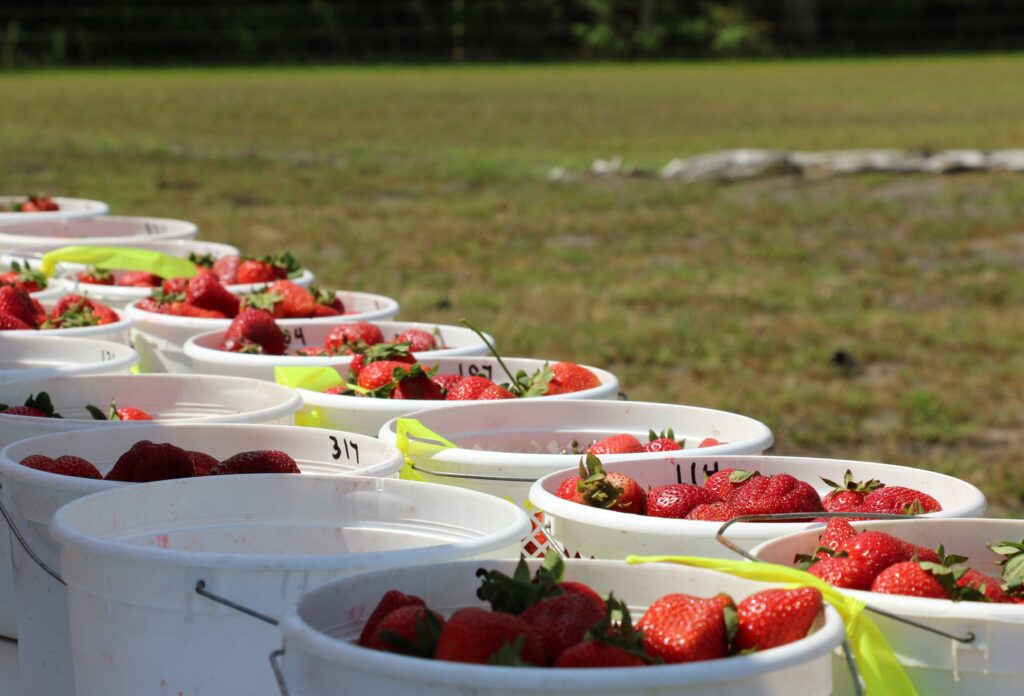
Strawberries grown at the NC State Horticultural Crops Research Station at Castle Hayne, where Extension breeders are working to develop a better berry.
North Carolina ranks No. 3 in national production of fresh market strawberries with between 1,500 and 2,000 acres of production. The industry is almost entirely based on small-to medium-size family farms, selling at U-pick and ready-pick roadside stands and in farmers markets in nearly all 100 counties.
“Almost everybody has a direct-to-consumer part to their operation” said Mark Hoffmann, small fruits Extension specialist with NC State. “We also grow different cultivars than you would in Florida or California. They have a different taste profile, they’re fresher.”
The growers include Austin and Christina Wrenn, who operate a strawberry and flower farm outside Zebulon in Nash County. They grow the berries in greenhouses and outside on 2 acres. They sell directly to their customers, primarily on weekends during strawberry season, roughly mid-April until the last weekend of May in their part of the state.
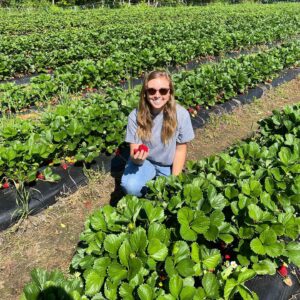
Christina Wrenn with a strawberry picked from the Wrenn’s Farm pick-your-own field.
“We encourage the U-pick customers to come out, but we also have pre-picked,” Christina said. “They are looking for a sweet berry with lots of flavor. It’s the whole farm experience.”
“They can meet the people who are doing the farming. We do ice cream and picnic tables and a tractor they can sit on. It gives them a way to get away from their home and relax and have a nice experience.”
The most common variety on U-pick farms in North Carolina is Chandler, which is noted for its good flavor, size and attractive color. Camarosa is gaining popularity with growers. It has similar characteristics as Chandler, but with better shelf-life and handling characteristics.
Both berries were developed in California and adapted for North Carolina. While they work well here, NC State Extension specialists are on a quest to grow a better berry for farmers and consumers.
“We are looking for new cultivars, new selections,” Hoffmann said. “We are looking for which cultivar selection works best in our particular environment.”
At research stations in Castle Hayne, Clayton and Salisbury, new varieties of strawberries are bred, grown and evaluated for their potential to become the new favorite of growers and buyers. The process starts when promising parents are crossed to create new seedlings.
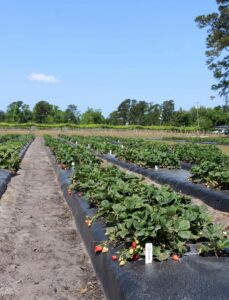
Strawberries growing at the NC State Horticultural Crops Research Station in New Hanover County.
“For example, we will identify a mom that has good flavor and a dad that has a high yield, and we make the cross with those two parents and hope that some of those kids have high yield and good flavor,” Fernandez said.
Each year thousands of seedlings are planted in the research field. By the end of the season about 1-2% will be identified with superior traits, given a selection number, and propagated for further evaluation.
The combination of high yield and good flavor — with a healthy dose of disease resistance, cold-weather tolerance and an attractive shape and color — is the holy grail for strawberry breeders.
The former is a must for farmers if they hope to make a profit from their crops. The latter will keep the consumer coming back for more.
“When you are buying the fruit, flavor is important,” Fernandez said. “To the grower, they want a berry that is disease resistant and high yielding. That package has to be all together. It’s hard. Some of our selections have good flavor but don’t have high yield, and vice versa. In fact, we know that yield and flavor are inversely proportional based on genetic research.”
Related: After picking your strawberries or buying them from a local farmers market, try these tasty recipes.
Rocco and Liz are NC State-developed cultivars that are now available to growers. Rocco is an early season, medium-small, soft berry with excellent flavor. Liz is a mid-late season, medium-large, firm berry with a high yield.
The NC State Extension strawberry team has also worked on adapting Ruby June, a California cultivar, for North Carolina. It is a large, firm berry with a medium-high yield that could be a Chandler alternative.
Those three varieties emerged from a development process that involves thousands of candidates and can take a dozen years. New selections are evaluated for yield and flavor every year. Promising ones are propagated and further studied.
It’s survival of the fittest — and the tastiest.
“It takes 10-12 years to develop a new strawberry cultivar (variety),” Fernandez said. “We start with seedlings, then evaluate selections, and finally the best selections are put into replicated trials. We then look at those selections for another three or four years, to determine if they will perform the same way each year and be reliable.”
Related: Learn more about strawberry cultivars in North Carolina.
The varieties in production in growers’ fields have names — Rocco, Liz, Ruby June. Those at the beginning of the process have an alphanumeric code. NC-20-17 is the 17th plot of a strawberry developed in North Carolina in 2020. NC-19-16 is the 16th plant deemed worthy of further trials from 2019.
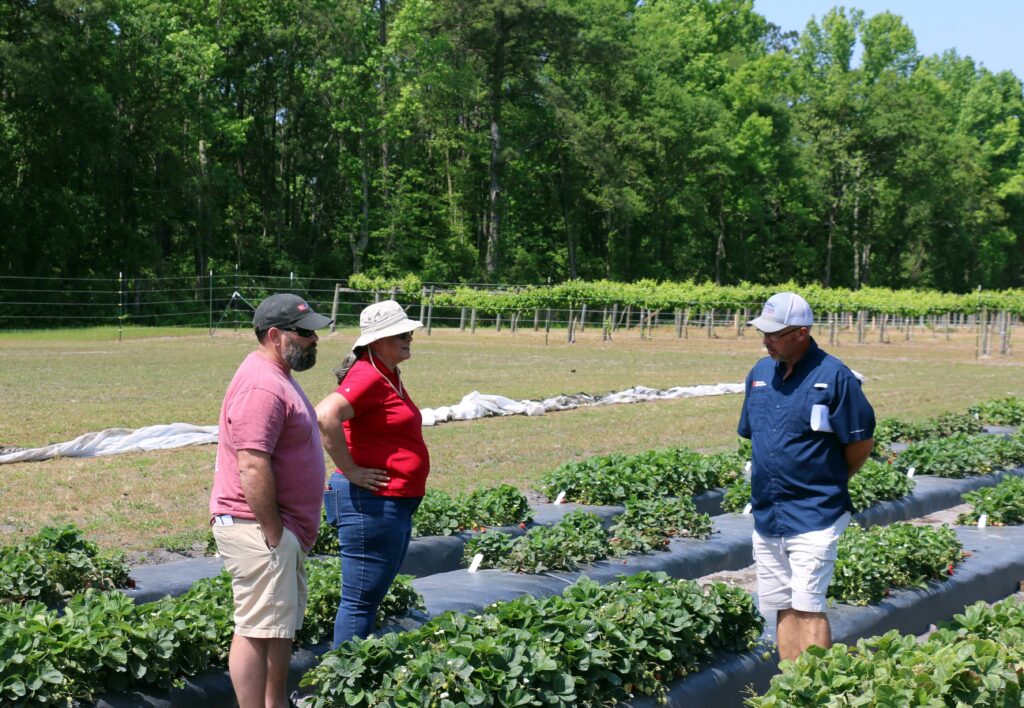
Gina Fernandez answers questions about promising new varieties of strawberries during a field day in May.
“We have each one of these selections replicated three times; NC 19-16 is out there in three different plots,” Fernandez said. “And we have the same basic planting at three different locations: Castle Hayne, at Clayton and at Salisbury. We take the yield data at all the locations multiple years. The fruit from Salisbury goes to Kannapolis [to the Plants for Human Health Institute] and they do sugar analysis and post-harvest storage tests. Then we take them out to growers’ fields in the later stages and see how growers like them.”
The evaluation process includes field days at NC State facilities. One took place in early May at the Horticultural Crops Research Station at Castle Hayne, just north of Wilmington in New Hanover County. Growers joined researchers, Extension agents, scientists and faculty members to see the latest varieties, discuss topics like non-fumigant methods to control disease, and conduct taste tests.
The research benefits strawberry farmers like Adam Grady, one of the growers at the Castle Hayne field day. His Dark Branch Farm comprises about 1,000 acres outside Kenansville in Duplin County. He has traditional row crops, along with beef and hogs. He recently added an acre-plus of strawberries.
“This is our first year growing strawberries,” he said. “We have a good mid-season varietal. I’m looking for a complement to that, an early-season variety and a late-season variety to add to it.”
Growers like Grady are one of the target audiences for Extension efforts.
“We help a lot of inexperienced growers, who might only have an acre, to battle their problems and to get started,” Hoffmann said. “That’s something the consumer directly benefits from because there is a healthy operation in their neighborhood they can pick from.”
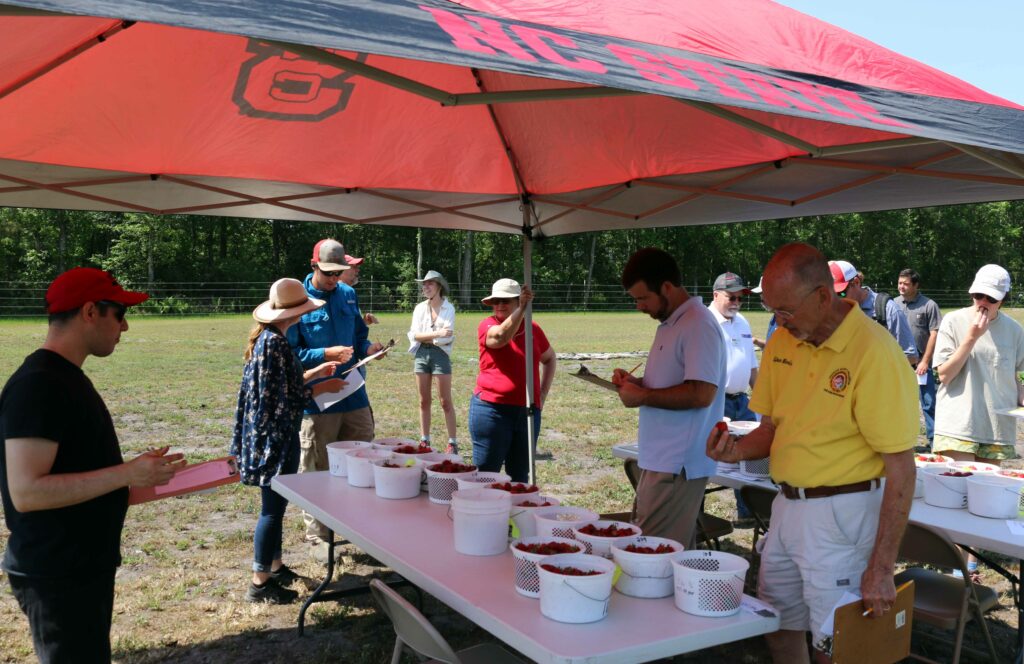
Taste tests like the one at the field day at the NC State Horticultural Crops Research Station in New Hanover County are important in evaluating new strawberry varieties.
“For me it’s just as much about the people, seeing what works and doesn’t work for them, what works in different areas,” he said.
Like all North Carolina farmers, strawberry growers are faced with significant cost issues in 2022.
“Supply cost, fertilizer cost, labor cost,” Hoffmann said. “That is a big problem this year.”
Hoffmann cites costs, the ongoing search for economically viable cultivars, and annual problems with plant diseases as the biggest obstacles. Those are significant barriers for new growers. But overall, the state of the industry is strong.
“We have a very stable population of strawberry growers,” Hoffmann said. “We might be at the saturation point, but it’s a very healthy industry.”
Anyone who has bit into a delicious, fresh-picked berry from this year’s crop would certainly agree.
NC State Extension’s Homegrown series shares more about strawberries in North Carolina and how to get the most out of your visit to a U-pick farm.

